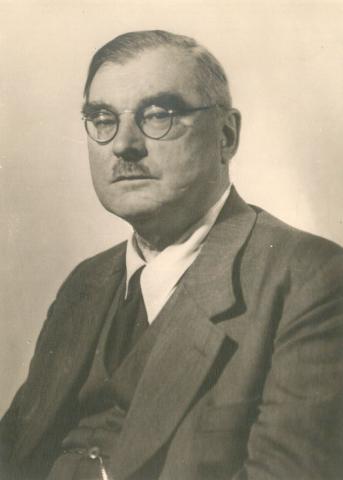Hans Demel von Elswehr was born in Teschen in 1886 as the son of the Silesian Reichstag member Johann Demel Ritter von Elswehr. In 1904 he matriculated in the Faculty of Law and Political Science in Vienna and obtained his doctorate in law in 1911. A year earlier he enrolled in the Faculty of Philosophy and studied Egyptian language and classical archaeology under Hermann Junker, Islamic languages, art history under Max Dvořák and Josef Strzygowski, and archaeology under Emil Reisch. In 1913 he wrote his doctoral thesis "On late Nubian vessels from the excavations by the Vienna Academy of Sciences under Professor Junker". In the same year he worked as an unpaid intern at the Kunsthistorisches Museum in Vienna and became an assistant in 1914. In 1922 he became head of the Egyptian Collection. He went on several study trips to Egypt, participating in 1926 in the excavations by the Vienna Academy of Sciences at the Pyramids of Giza. In 1934 he was elected as a regular member of the Deutsches Archäologisches Institut (German Archaeology Institute). Together with his colleagues Eduard Holzmair (coins) and Leopold Ruprecht (weapons) and the librarian of the Akademie der bildenden Künste (Academy of Fine Arts) Anton Kraus, Demel travelled at the end of 1939 by order of the Reich Minister of Education Bernhard Rust to Poland, where he had contact with Kajetan Mühlmann, who had been appointed "Sonderbeauftragter für den Schutz und die Sicherung von Kunstwerken in den besetzten Ostgebieten" (special representative for the protection and securing of artworks in the occupied territories in the East). During the war, Demel deputized for Fritz Dworschak in air raid protection matters and from November 1941 was head of the administration and personnel department, with the exception of the affairs of official researchers. In 1942 he was given a teaching course at the University of Vienna. He was to have retired at the end of December 1951 but died suddenly of a heart attack beforehand.
Hans Demel (von Elswehr)

Morris L. Bierbrier, Who was who in Egyptology, 4th revised edition, London 2012.
Franz Heiduk, Oberschlesisches Literatur-Lexikon, Teil 1: A–H, Berlin 1990.
Hermann Junker, Das Kloster am Isisberg. Bericht über die Grabungen der Akademie der Wissenschaften in Wien bei El-Kubanich, Winter 1910–1911. 3. Teil. Mit einem Abschnitt von Hans Demel, Wien 1922.
Hermann Junker, Ermenne. Bericht über die Grabungen der Akademie der Wissenschaften in Wien auf den Friedhöfen von Ermenne (Nubien), im Winter 1911/12. Mit einem Abschnitt von Hans Demel, Wien 1925.
Hans Demel, Die Reliefs der Kultkammer des Kaninsut und ihre Stellung in der Kunst des alten Reiches, in: Jahrbuch der Kunsthistorischen Sammlungen in Wien (1929) N.F. 3, 5–24.
Hans Demel, Der Totenpapyrus des Chonsu-Mes, in: Jahrbuch der Kunsthistorischen Sammlungen in Wien 13 (1944), 1–16.
Hans Demel, Ägyptische Kunst, Wien 1947.
KHM-Archiv, III 249, PA Hans Demel; IV 24, NL Hans Demel; 74/KORR/1939/40; 280/KL/1939, 322/KL/1939.
OeStA/AdR, BMU, Personalakten, 3/28, Hans Demel.
